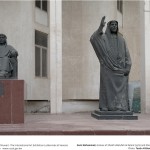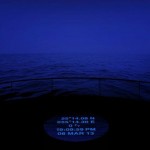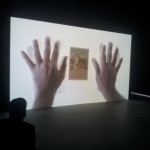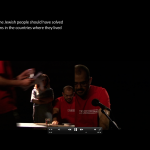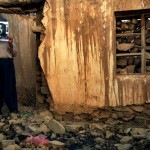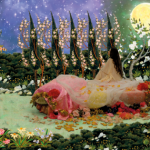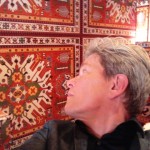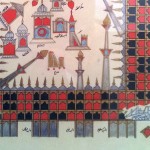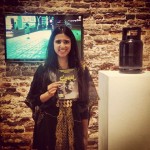This is the text of an article I submitted to Harpers’ Bazaar Art Arabia. It will be published in their upcoming issue as ‘Last Word’, on the last page.
A quietly encouraging note is struck by artists from the Middle East in this year’s Venice Biennale. The din of fanfare that accompanied previous participations has subsided. The national pavilions and collateral events by the UAE, Kuwait, Palestine, Lebanon and Turkey have noticeably matured. Instead of aping or ingratiating the Western art world, they genuinely add to the plurality of voices in this colossal art-fest. What is it? Something akin to a note of reflection, almost sadness, indicating a solid measure of historical contemplation in a region often seen as superficially bound to the present.
The self-congratulating, celebratory tone that the art world generally encourages – which causes it to be despised by many critical thinkers – is not to be heard in these national participations. Kuwait bends over its own failed dreams of modernisation, analysing the genealogy of national myth-making (Sami Mohammed) and its subsequent demise (Tarek Al Ghoussein). The UAE surprises all with the solo of Mohammed Kazem, consisting of one giant work, intimate, subdued and intelligent, while a comprehensive accompanying catalogue details the long and self-critical career of the artist. The interrogation of history in which Lebanese artists seem to excel, is taken to the next level by Akram Zataari’s ‘Letter to a Refusing Pilot’. The Palestinian participation, wittily named ‘Otherwise Occupied’, shows only two works of art but it is impressively pluralist nonetheless: Aissa Deebi’s stammering and hopelessly inconclusive movie ‘The Trial’ and Bashir Makhoul’s interactive project (allowing visitors to make and place their own cardboard home in the garden) provide completely different takes on current developments in Palestine. Turkey’s Ali Kazma overpowers visitors with a thorough video installation on methods and technologies of control of the body, and the body’s resistance to them.
All these pavilions are well curated, a far cry from the (still recent) days when political concerns and art-world cronyism seemed to dominate over issues of quality, when selecting the teams charged with representing Middle-Eastern countries. It has now become a very professional affair.
Of course not all pavilions of the MENA region are equally successful. Bahrain, after two great showings at the Venice Architecture Biennale (2010 & 2012) has made a rather unremarkable entry with three artists, of whom two display rather immature work. Egypt has lamentably gone for a sensational nationalist experience by coaxing visitors into a kitschy remake of a pharaoh’s tomb; this sends an odd and disturbing signal, knowing what the country is going through. Iraq seems to have fallen victim to its neo-colonial status. The daughter of the CIA-backed presidential hopeful of 2003, Chalabi, snatched the commission from more qualified Iraqi curators and invited an English gentleman-curator to come explore the Iraqi art scene. Although his take is generous, including some energetic young artists such as Jamal Penjweny, the overall impression he inevitably gives is that Iraqi artists are trapped in some kind of time-warp.
One of the countries whose absence from Venice is painful is Iran. Hopefully some independent collective will be able to organize a strong showing of contemporary Iranian art at the next Biennale. In this edition Iranian artists are, surprisingly, represented through the efforts of Azerbaijan. The oil-rich Caucasian country spent lavishly on Venice, both in its sprawling official pavilion and in the very cool and innovative ‘Love Me, Love Me Not’ collateral event sponsored by Baku’s private Yarat Foundation. The latter exhibition shows Iranian artists such as Farhad Moshiri, Afruz Amighi, Shoja Azari and Mahmoud Bakhshi alongside Azeri and other artists from neighboring states. The whole show is imbued with Slavs & Tatars’ dazzling cultural hybridity.
Edge of Arabia seemingly takes a step back from the art market by presenting the younger generation of Saudi artists and artistic initiatives; for visitors with the usual bias it may be an eye-opener, but one wonders what effect it has on a young artist’s motivation to have your first exhibition at the Venice Biennale. Nevertheless ‘Rhizoma’ nicely captures the energy of the Saudi art scene.
Artists from the broader Middle East region are almost completely absent from the main exhibition of the Biennale, the Encyclopedic Palace. Surely if the curator Massimiliano Gioni would have researched further, he could have integrated fascinating regional examples of artists obsessed with the exhaustive reproduction of their idiosyncratic worldview. But luckily artists and curators from the Middle East no longer need the West to engage or even represent them; this year’s Biennale demonstrates that they have their own, highly individual voices to add to the global art chorus.
- Aissa Deebi: The Trial
- Ali Kazma: Resistances
- Ahmed Angawi
- Young Saudi artist in Venice
Back to Venice Biennale 2013 review main page

